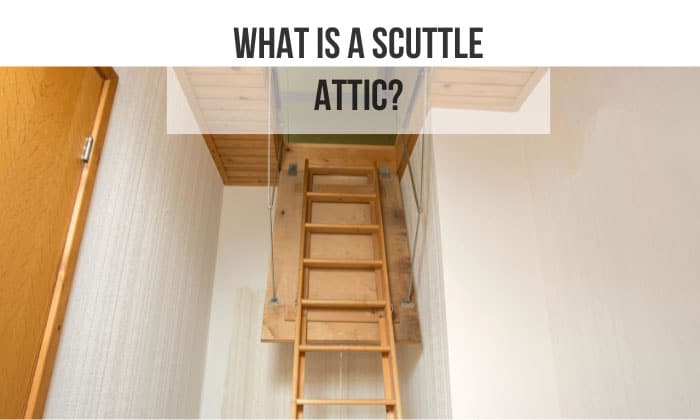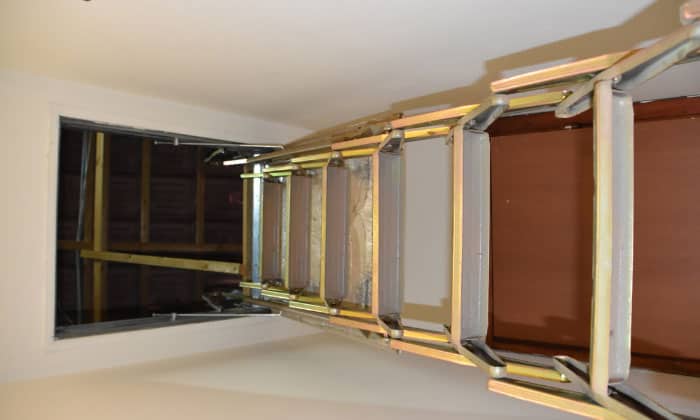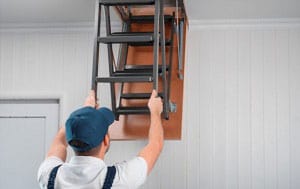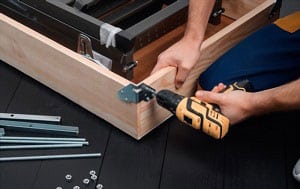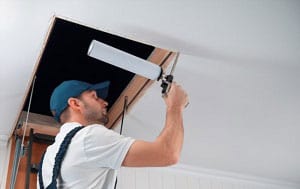Whenever there is plenty of space between the roof and the top floor, it’s crucial to think about the types of attics and, from there, determine proper ventilation. Otherwise, you can encounter issues such as poor insulation, decreased roof lifespan, damage to paint/wallpaper, and mildew development.
If you’ve heard about the 5 main varieties of storage lofts, you may wonder, “What is a scuttle attic?” To put it simply, this attic type is characterized by a small opening in the ceiling. To access it, you’ll have to either climb a ladder or a pull-down stair.
Table of Contents
All You Should Know About Scuttle Attics
1. The key features of scuttle attics
More commonly seen in older buildings, scuttle attics can only be accessed through a small hole with a minimum dimension of 24”x24” or 22”x23” in the ceiling or the wall, depending on its type.
01 Attic hatch (access-point attic)Located on the ceiling, this type has a detachable attic scuttle hole cover, which you need to push on to open. Because it’s often the choice for narrow areas, this type doesn’t have a drop-down staircase. Instead, you’re expected to carry a ladder to the attic yourself.
An access-point attic is a very common choice in residential homes – one reason being its low installation cost. If anything, making a covering panel for attic hatches is simple enough to be a DIY project.
02 Spring-loaded doors (drop-down ladder)Again, this type is located on the ceiling. The primary difference between the prior kind of scuttle attic vs drop stair is that the latter has a built-in drop-down ladder. It also has a hanging cord that you can pull on to open the panel and gain access to the metal or wood fold-away ladder.
This scuttle hole attic type is favored for its convenience, but its complicated setup means a heftier cost for installation.
In addition, it also takes up more space to accommodate the scuttle attic ladder, requiring at least 28 inches and 44 inches of space for height and depth, respectively.
03 Knee-wall doorThe scuttle hole can also be in the wall, but this rarely ever happens. As is already implied in the name, this type is installed in the wall. Because they don’t require a scuttle hole ladder, such attics can only be found on the top floor of a Cape Cod-style house.
While this attic scuttle size may not actually be knee-height, its opening is usually short enough that you’ll have to crouch to get through.
Beside the hallway, a scuttle door can also be located in a closet, provided that it meets the minimum size for an attic access mentioned above. While the actual attic scuttle size can vary, the free space above the door only needs to be at least 30 inches. This is why this area can be so small that you’ll have to crouch to get around.
The material used for covering the scuttle hole is typically drywall. You can also come across scuttle attic panels made from wood and plywood. And as these attics are notoriously poorly insulated, it’s essential to add in foam, weather stripping, or batt insulation.
2. Parts
The components of a scuttle attic are very simple. For starters, you have the opening that meets the minimum scuttle hole size for access to the loft. This opening can be finished with attic access framing for a more eye-catching look.
No matter the type, the scuttle hole will always have a covering panel. You can look up ceiling attic access door ideas to either decorate or hide it. One of the most common methods, however, is painting the attic door the same color as the ceiling/wall.
Spring-loaded scuttle attics also feature a foldable ladder.
3. Things you need to create a scuttle attic
If you’re considering doing a scuttle attic conversion yourself, the list of necessary tools is quite long. At the very least, you’ll need cutting tools, including a circular saw, Miter saw, utility knife, and drywall knife.
If you intend to frame the scuttle hole, a nail gun with nails long enough to pierce the joists is necessary. Then, to finish a scuttle attic, you’ll have to prepare a caulk gun, paint, and prime.
Should you want to install a drop-down ladder, note that there needs to be decent support, which is the joists in this case. To know where the joists are located, use a stud finder.
4. The cost to make it
If you create the scuttle attic yourself and you already have the necessary tools, the cost for the project is shockingly low—only around $25. However, professional installation will require a budget of at least $220.
Note that the cost above may not cover the ladder, which is at least $80 for a cheap wooden one. Something like aluminum or steel will have a higher starting price, with $250 and $600 being the minimum amounts, respectively.
Maintenance Tips
Poor insulation aside, scuttle attics are also prone to pests, so make sure the door closes tightly. In addition, occasionally check the attic for signs of animal droppings or nests to determine the proper course of action. If the problem is too severe, consider getting help from professionals.
It’s also a good idea to set up a ventilation system and look for signs of mold every so often.
Frequently Asked Questions
What is the importance of a scuttle attic?
A particular reason scuttle attics are so well-liked is that they don’t take up a lot of space or get in the way, particularly attic hatch ones. They are also relatively cheap, giving you easy access to decent storage space without costing you an arm and a leg.
What are the tips to insulate a scuttle attic hole?
To insulate a scuttle, duct tape two to three 2-inch-thick pieces of foam board to the back of the covering panel, depending on how poor the insulation is in the first place.
Then, stick weather stripping to four sides of the hole opening’s upper part. Once you’re done, close the scuttle hole and call it a day.
How to hide a scuttle hole?
Other than painting the hole’s cover with the same color as its surrounding, another way to hide attic door in ceiling is by installing a decorative light box. However, as the light fixture is supposed to cover the hole, it can also make accessing the attic more challenging.
How do you use a scuttle attic?
Should your scuttle attic be too small, use it as a storage space – just make sure the stashed-away items aren’t so heavy that they’ll sag the ceiling.
On the off chance that the scuttle attic is large enough to be turned into a living space, you can turn it into a bedroom, a reading area, or a game room.
Conclusion
What is a scuttle attic? By now, you should be able to define scuttle attic meaning and its main types.
If you have one of these in your home, remember to insulate it well. Otherwise, the attic can drive up your energy bill and/or invite unwanted pests to invade your home. For this reason, I’d recommend having an expert over to make sure the scuttle attic is up to standard and follows the building code.

Hi, I am Roseanne Jones, an aspiring home designer that wants to make you feel more at home with your new house.With nearly five years of redecorating old residents and arranging new ones, I am confident that I can give you the best advice on your lovely place.


